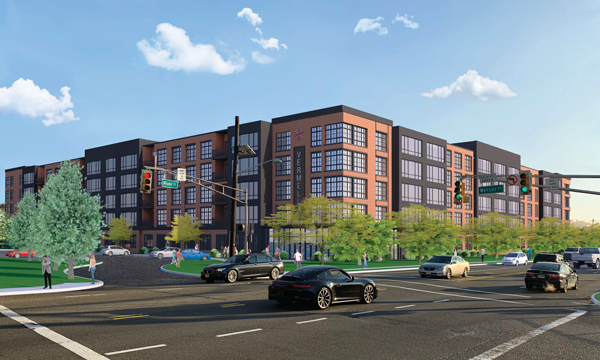Trending
How Hackensack is betting big on OZs

As the real estate industry gradually warms to the Opportunity Zone program, which provides tax relief in exchange for investing in low-income areas, a small city in northern New Jersey is being closely watched as a test case.
Located about 45 minutes from Manhattan by train but with a downtown lacking the vitality of some of its neighbors, Hackensack has become an ideal investment target, said several brokers, city officials and developers. The city, which has a population of about 45,000, embarked on a redevelopment plan in 2012.
At the time, Hackensack’s downtown had been without a new building since the 1980s. The city sought to court real estate investors by offering tax breaks and paying for infrastructure projects, both of which contributed to a slight real estate rebound. But now the city also boasts three of New Jersey’s 169 approved OZs.
Hackensack’s boosters say the signs of a turnaround are attracting developers. While they admit that the OZ program — shoehorned into the 2017 federal tax overhaul — has been slow to catch on in the real estate sector, the dollars are finally starting to flow and show in places like Hackensack.
“There’s been a night-and-day difference between the Hackensack of a few years ago and today,” said Michael Brown, a vice president at McBride Corporate Real Estate in Paramus who frequently works in the city.
Fueling at least some of the interest in Hackensack, Brown said, are OZs that sparked an “amazing” level of interest in a development site at 11-19 Orchard Street, which came on the market two months ago for $1.5 million. “Hackensack is a nice crucible to see what’s going on [with OZs],” he said.
Dense districts
Hackensack trails behind such nearby municipalities as Jersey City, Newark and Paterson in its number of specially designated OZs.
But the three OZs in Hackensack proper — a fourth is located in the separate township of South Hackensack, according to the New Jersey Department of Community Affairs (DCA) — encompass about half of the area of the nearly 4.4-square-mile city. One OZ comprises Hackensack’s downtown, a modest strip of discount clothing stores, Ecuadorian restaurants and government offices that is mostly quiet at night.
Another zone covers the Fairmount neighborhood in northern Hackensack, while a third is located near Essex Street and includes Hackensack University Medical Center, a top-rated hospital and major employer undertaking a four-year, $714 million expansion. That development will add a 300,000-square-foot tower on Second Street that will have operating and recovery rooms.
Designed to help investors delay or avoid paying capital gains taxes, while encouraging the private sector to help revive faded communities, OZs channel money to development sites via funds of pooled capital. As of early May, at least two such funds are focused exclusively on New Jersey, according to the National Council of State Housing Agencies, a nonprofit that tracks OZ funds.
One is BrookRoad Capital, a $50 million fund scoping out a range of projects in the Garden State. A call to the fund was not returned. There’s also the $50 million PEEK Opportunity Fund I, a creation of East Orange-based apartment developer Equis Realty Partners and Teaneck-based multifamily investor the Fountain Group. The fund is targeting 65- to 125-unit projects in North Jersey cities; the developers will chip in up to 20 percent of the equity on such deals. PEEK declined to comment.
Similarly, former New Jersey Gov. Chris Christie recently co-founded a property investment fund hoping to raise $150 million to take advantage of OZs. He partnered with the Hampshire Companies, a Morristown-based real estate investor that’s busy with several Hackensack development projects.
Rentals rising
All told, Hackensack has about two dozen major development projects with several thousands units that are either planned, in progress or recently completed, according to the city’s economic development office. Most are multifamily rentals.
The largest project appears to be a mixed-use development in a waterfront parcel OZ at 150 River Street, which used to be the home of the Record newspaper and printing plant, but has now been vacant for years. Planned for the 20-acre site, where foundations were poured in May, is a 654-unit, five-building rental complex that will also have 18,000 square feet of retail space and paths along the Hackensack River.
The first 272-unit residential building — mostly studios and one-bedrooms — is expected to be completed in two years. Joining forces on the phased, $145 million project are Hampshire and Carlstadt-based Russo Development, as well as Fourth Edition, a real estate firm founded by the Borg family, which owned the Record for decades before selling the newspaper to Gannett in 2016.
Located in an industrial area, the private development has been the beneficiary of significant public support. In January, Hackensack’s city council agreed to waive property taxes and asked developers to pay a lower annual fee, otherwise known as a payment in lieu of taxes (PILOT), over a 30-year period. While some have criticized the length of such tax abatement programs, Hackensack officials have generously deployed them, arguing that in some cases the parcels involved had previously been tax-exempt.
Developers behind the former Record building are also trying to line up equity from OZ investors, presumably for later phases of the project. The River Street parcel is listed on the website of New Jersey’s DCA, which maps the state’s OZs and flags projects in search of funds. It remains unclear, however, if a funding match has been made. Neither Hampshire nor Russo returned requests for comment.
Fourth Edition president Stephen Borg said that as the property owner, he is not as involved with the project’s financial strategy, so he could not discuss the OZ component. “It’s exciting,” Borg said. “We’re definitely energized.”
Hampshire has other OZ investments in Hackensack. The company has partnered with Bridgewater, Massachusetts-based Claremont Companies on an 82-unit rental development at 389 Main Street, which broke ground last year with 3,500 square feet of storefront. Hampshire also acquired the former Arena Diner at 250 Essex Street, where it’s planning another OZ-based rental building. A “cocktails” sign was all that remained of the famous local diner on a recent afternoon.
Meridia Metro, a 222-unit luxury rental building at 100 State Street, built in 2016 by Linden-based developer Capodagli Property Company, was among the first completed projects in the current development wave. Capodagli, which did not return a request for comment, is now at work on Meridia on Main, a five-story, 105-unit building in the heart of Hackensack’s downtown that’s been awarded a 15-year PILOT.
Similarly notable projects that could grab the attention of OZ funds include the $35 million conversion of an Art Deco bank at 210 Main Street and an adjoining building into a 126-unit rental by Ridgewood-based Heritage Capital Group.
Clearer understanding
Hackensack has other OZ-related deals in the pipeline.
In May, a small State Street development site in an OZ last listed for $1.1 million went to contract with a developer new to the city, said Keller Williams associate broker Gina Palumbo. Although she declined to discuss further details until the sale closes, Palumbo noted that 20 apartments are planned for the site.
Palumbo also said that she recently sold 77 River Street in Hackensack for $2.2 million to a rock climbing gym, a sign that OZ sites could spur other kinds of investments. Palumbo added that since the U.S. Department of the Treasury released its long-awaited second set of guidelines for OZ investments in April — which removed the shroud of mystery that surrounded the program — Hackensack has experienced an uptick in investment interest.
Among other rules, the new OZ regulations state that buildings that have been vacant for five years can be considered developments for the sake of the program, which could open up even more sites in rough-edged downtowns.
Besides PILOTs, Hackensack has created a special 163-acre downtown district by upzoning blocks to allow buildings up to 14 stories, a key change in a mostly one- and two-story landscape The city also upgraded its infrastructure by installing historic-looking lampposts along sidewalks and making its Main Street more pedestrian friendly.
“The city is really trying to improve upon the quality of life, to encourage people to live and work in one place,” Palumbo said.




